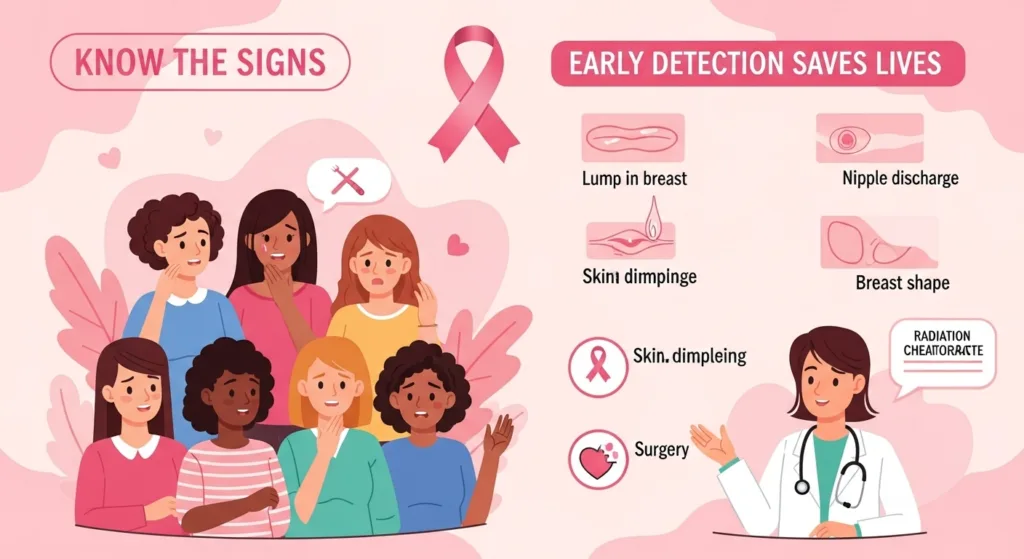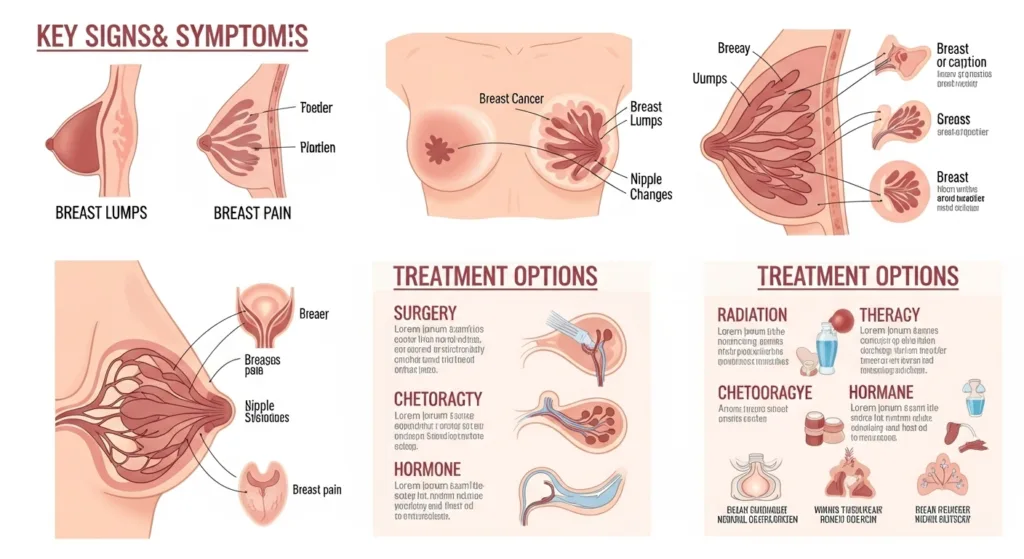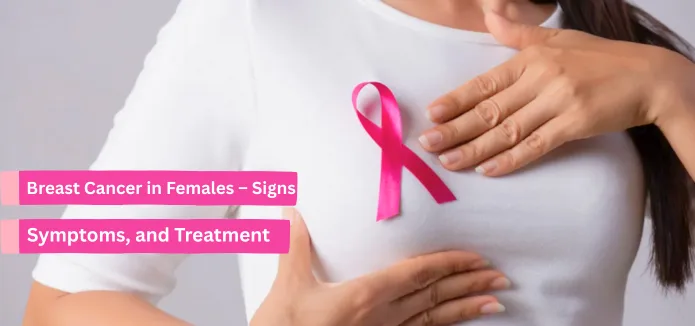Breast cancer is one of the most common and serious health concerns affecting women worldwide. In 2025, it remains a leading cause of cancer among females, but thanks to early detection and advanced treatments, survival rates continue to improve.
Breast cancer usually occurs when the cells in the breast start growing uncontrollably and start forming lumps that, over time, develop into a tumour or mass. It is typically seen in older women who are over 50, but it can also occur in younger women and, in rare cases, even in men.
What Is Breast Cancer?
Breast cancer starts when cells in the breast begin multiplying uncontrollably, forming a lump or mass. These cancer cells, when left unchecked, can move to nearby tissues or spread to other organs in the body, such as the lungs, liver, or bones. Initially, it starts in the ducts or lobules and can occur in one or both breasts, often going unnoticed until symptoms appear.
Types Of Breast Cancer
Healthcare providers classify breast cancer into two main types and several subtypes to make it clearer which type a patient has, how aggressive it is, and what treatment options will be most effective.
Breast cancer presents differently, and how it reacts to treatment also differs. A deeper comprehension of it will facilitate tailored care and improved results. Common types of breast cancer are:
- Invasive Ductal Carcinoma (IDC): It starts in the milk ducts and spreads into the nearby tissues, resulting in more than 200,000 diagnoses in the U.S. each year.
- Lobular Breast Cancer: This breast cancer starts in the milk-producing glands (lobules) in your breast and often spreads to nearby breast tissue. It’s the second most common breast cancer in the United States.
- Ductal Carcinoma In Situ: Ductal carcinoma in situ (DCIS) is a very early, non-invasive breast cancer. It starts in the milk ducts and remains within them. It doesn’t invade surrounding tissue and is usually easy to treat.
- Triple-Negative Breast Cancer (TNBC): This type of cancer is aggressive; it expands and grows at a faster rate compared to other forms of breast cancer.
- Inflammatory Breast Cancer: Inflammatory breast cancer (IBC) is a rare and fast-spreading type of cancer that usually doesn’t have hormone receptors, which makes it harder to treat.
- HER2 Positive Breast Cancer: HER2-positive breast cancer has too much HER2 protein, which makes cancer grow faster, but it often responds well to targeted treatments.
Common Signs And Symptoms Of Breast Cancer In Females

Breast cancer can show up in different ways, some of which are obvious and some of which are less so. This is why it’s so important to be aware of any changes in your breasts. Some common signs that need to be taken care of are:
1. A Lump In The Breast, Arm, Or Underarm
A lump in the breast, arm, or underarm area is often the first sign that something may be wrong. While not all lumps are cancerous, it’s important to have any new lump checked by a doctor.
2. Changes In The Breast Or Shape
A sudden change in the size or shape of your breast could signal abnormal changes in the breast tissue and may be an early sign of breast cancer that needs medical attention.
3. Nipple Change
Changes in the nipple, such as inversion (nipple turning inward), unusual discharge (especially clear or bloody), or persistent itching or scaling, can be signs of breast cancer.
4. Change In Skin Texture
If the skin on your breast starts to dimple or pucker(like an orange peel) and gets red, warm, or swollen, it could be inflammatory breast cancer.
5. Persistent Pain
Breast pain isn’t always a sign of cancer, but if the pain doesn’t go away over time, is persistent, and is in one spot, you should see a doctor for a proper diagnosis.
6. Swollen lymph nodes
Breast cancer can spread to nearby lymph nodes, especially those under the arms or near the collarbone. This can cause swelling, lumps, or tenderness in these areas, which are often signs that the cancer is getting worse.
Some Uncommon Symptoms Of Advanced Breast Cancer

If untreated, breast cancer can progress, and the associated signs and symptoms may also worsen. Like:
- Bone pain
- Shortness of breath
- Jaundice
- Seizures or headaches
- Extreme fatigue or weight loss
What Causes Breast Cancer?
Experts know that breast cancer starts when healthy breast cells change and grow out of control, forming a lump or tumour. While it’s not always clear what causes these changes, research has found certain factors that can increase your risk of getting breast cancer. These include:
- Age: Risk increases after age 55.
- Sex: Women are much more likely to get breast cancer than men.
- Family History: If close family members (like a parent, sibling, or child), had breast cancer, your risk is higher.
- Genetics: Some people inherit gene changes (like BRCA1 or BRCA2) that raise the risk.
- Smoking: Using tobacco is linked to many cancers, including breast cancer.
- Alcohol Use: Drinking alcohol regularly can raise your risk.
- Obesity: Being overweight, especially after menopause, increases the risk.
- Radiation Exposure: Having radiation treatments to the chest, head, or neck in the past raises the risk.
- Hormone Replacement Therapy (HRT): Taking hormones for menopause symptoms may increase your risk.
Stages Of Breast Cancer
| Stages | What does it mean? | Spread |
| Stage-0 | Very early stage, cancer is only in the milk ducts | No spread |
| Stage-1 | Small tumour, just starting to grow into nearby tissue | May or may not spread to a few lymph nodes |
| Stage-2 | Larger tumour or has spread to nearby lymph nodes | Local spread |
| Stage-3 | More seriously, cancer has spread more widely in the breast area | Spread to many lymph nodes or the chest wall |
| Stage-4 | Advanced stage, cancer has spread to other parts of the body. | Spread to organs like bones, lungs, and liver |
Diagnosis Of Breast Cancer
To look for signs of breast cancer, doctors may do a physical exam. To be sure of a diagnosis, they might also do the following tests:
1. Mammogram: A mammogram helps spot unusual breast lumps or tissue development in its initial stages.
2. Breast Ultrasound: Ultrasound uses sound waves to examine breast lumps or tissue changes.
3. Breast MRI (Magnetic Resonance Imaging): MRI offers detailed pictures, particularly useful for dense or high-risk breast tissue.
4. Biopsy: A biopsy examines a tissue sample to verify the kind and stage of cancer.
5. Hormone Receptor Tests: Evaluate whether cancer cells contain receptors for the hormones estrogen or progesterone.
6. HER2 Test: Identifies if cancer cells have too much HER2 protein, guiding the use of specific therapies.
7. Genomic Testing (e.g., Oncotype DX): Estimates recurrence risk and assesses if chemotherapy will be effective.
8. CT Scan or PET Scan: Determines if the cancer has extended to different areas of the body.
9. Bone Scan: Determines whether breast cancer has extended to the bones
10. Chest X-ray: Used to check if breast cancer cells have spread to the lungs or nearby areas.
11. Blood Tests: Used to assess overall health and organ function before and during breast cancer treatment.
Treatment Of Breast Cancer
To treat breast cancer effectively, doctors may recommend a combination of therapies based on the cancer type, stage, and your overall health.
1. Surgeries
One of the most common ways to treat breast cancer is with surgery, which is meant to get rid of cancerous tissue and stop it from spreading. Finds out if breast cancer has spread to the bones.
- Lumpectomy: Surgically removes the breast tumour and a small amount of healthy tissue around it for safety.
- Mastectomy: Remove one or both breasts to manage or greatly lower the risk of breast cancer.
- Lymph node removal: Done to remove underarm lymph nodes when cancer spreads there, helping check its spread and plan further treatment.
2. Radiation Therapy
Radiation therapy kills breast cancer cells with high-energy X-rays or particles. Most of the time, it is given from the outside with a machine that sends precise beams to the area that needs it.
3. Chemotherapy
Chemotherapy is a way to get rid of breast cancer cells by using anti-cancer medicines, which are usually given through IV or pills, and can be used before or after surgery to keep cancer from spreading.
4. Hormonal Therapy
Hormonal therapy is used to treat breast cancer by blocking or lowering the levels of hormones(like oestrogen) in the body. This slows or stops the growth of cancer. It is mostly used for breast cancers that are hormone receptor-positive, and you can take it as pills or shots.
5. Targeted Therapy
Targeted therapy uses specialised medicines to attack specific molecules or genes in cancer, like HER2, without harming healthy cells.
6. Immunotherapy
Immunotherapy helps your immune system get stronger so it can find and kill cancer cells more easily. It is very effective in treating triple-negative breast cancer.
Will I Ever Feel Like Myself Again After Breast Cancer?
After treatment for breast cancer, it’s normal to feel a lot of different things, like relief, fear, sadness, or even confusion. A lot of women say they feel different, both physically and mentally. After treatment, healing doesn’t stop. Take your time. Get in touch with someone, join a support group, or talk to a therapist. It’s okay to ask for help, and you’re not alone.
Getting better emotionally is just as important as getting better physically. You can keep working on things long after your medical care is over. It’s okay to feel weak while you get your strength back. Be nice to yourself and remember what you’ve done.
The Side Effects Of Treatment That Can Affect Your Health?
| Treatment | Side Effects |
| Surgery | Pain or soreness Swelling or bruising Scarring Numbness in the chest or arm Arm swelling |
| Radiation Therapy | Tiredness Skin redness or peeling Breast or chest pain Swelling |
| Chemotherapy | Hair loss Nausea and vomiting Feeling very tired Mouth sores Brain fog Period changes or infertility Risk of infection |
| Hormone Therapy | Hot flashes Mood swings Vaginal dryness Joint or bone pain Bone thinning |
| Targeted Therapy | Tiredness Skin rashes Heart problems Diarrohea Liver issues |
| Immunotherapy | Tiredness Skin rashes Cough Inflammation of glands Autoimmune problems |
| Long Term Effects | Ongoing tiredness Focus problem Bone weakness Mood issues Infertility Risk of second cancer |
Living With Stage 2 Breast Cancer: What To Expect?
Stage 2 breast cancer means that the cancer hasn’t spread very far and is still treatable. With the right care, a lot of women go on to live long, healthy lives. Being positive, following your doctor’s advice, and making small healthy changes every day can make a big difference. You’re not alone; there is always help and hope nearby.
You can improve your well-being while undergoing treatment by attending regular doctor visits, remaining active, eating a nutritious diet, and surrounding yourself with supportive individuals. Don’t hesitate to seek assistance when you need it, addressing both your physical and emotional needs. Each small step you take brings you closer to recovery and a healthier life ahead.
Raising Breast Cancer Awareness
Due to worldwide initiatives, pink ribbon efforts, and improved education, breast cancer awareness has significantly increased. Despite this, many women still overlook early indicators or face obstacles accessing timely screenings.
Simple Ways to Spread Awareness:
- Teach women how to do monthly breast self-exams
- Encourage regular mammograms, especially for women over 40
- Promote genetic testing for those with a family history (e.g., BRCA gene)
- Organise local events and walks during Breast Cancer Awareness Month (October)
Takeaway
Breast cancer is just one part of your life, not the whole thing. Thanks to early detection and strong treatment options, more women are not only surviving but also doing well. Know your body, trust your gut, and never ignore the signs. The first step to healing and hope is to be aware.
No one goes through breast cancer alone, from stage 2 to triple-negative. Regular checkups, open conversations, and help from the community can make a big difference. Let’s stop being quiet, lift each other up, and make a world where breast cancer meets strength, not fear.
The Most Asked Question About Breast Cancer In Females
1. What is the survival rate of breast cancer?
The stage at which breast cancer is diagnosed affects how likely it is to survive. The 5-year survival rate for localised breast cancer (cancer that is only in the breast) is about 99%. The rate for regional spread (nearby lymph nodes) is about 86%, and for distant (metastatic) breast cancer, it drops to about 30%. Finding it early makes a big difference in the results.
2. Is breast pain always a sign of cancer?
Most of the time, breast pain isn’t a sign of cancer. It is often caused by changes in hormones, fibrocystic changes, or infections. But you should see a doctor if you have any persistent, sharp, or strange breast pain to be sure.
3. Can you get breast implants after breast cancer surgery?
Yes, breast implants are a common choice for women who have had breast cancer surgery and want to rebuild their breasts. After a mastectomy, a lot of women choose implants to make their breasts look better and feel better about themselves.
Reconstruction can be done right away during cancer surgery or put off until after treatments like radiation or chemotherapy. Your healthcare team will help you figure out the best and safest time based on your specific case, your overall health, and your own preferences.
4. Are all breast lumps cancerous?
Not every lump in the breast is cancer. Most of the time, these things are not harmful and are caused by things like hormonal changes, cysts, or benign growths like fibroadenomas. But it’s very important to have a doctor look at any lump or change. Early evaluation gives you peace of mind, and in very rare cases, it can save lives. Don’t ignore the signs; always listen to your body.
5. What does a breast cancer lump feel like?
A lump in the breast that is cancerous often feels like a hard, oddly shaped mass that doesn’t move easily under the skin. It could hurt or not hurt at all. Cancerous lumps usually feel hard and stuck in one place, while benign lumps are softer, smoother, and can move. If you see any strange changes, you should always see a doctor.
6. Do bras or underwire really increase breast cancer risk?
No, wearing bras or underwire bras does not make you more likely to get breast cancer. A lot of people believe this. Studies by the American Cancer Society and the National Cancer Institute, among others, have shown that there is no link between wearing a bra and getting breast cancer.

